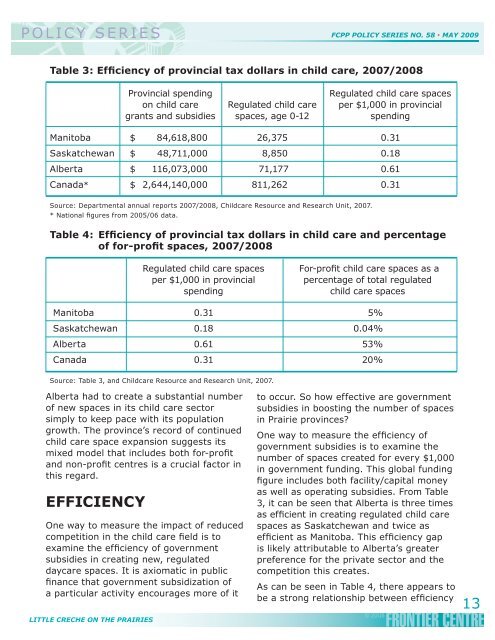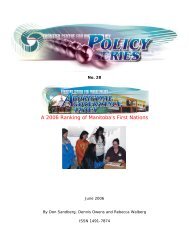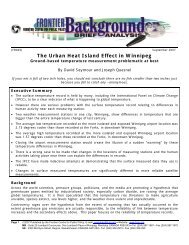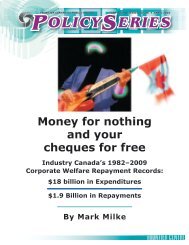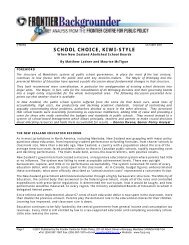POLICYSERIES - Frontier Centre for Public Policy
Create successful ePaper yourself
Turn your PDF publications into a flip-book with our unique Google optimized e-Paper software.
P O L I C Y S E R I E S<br />
FCPP POLICY SERIES NO. 58 • MAY 2009<br />
Table 3: Efficiency of provincial tax dollars in child care, 2007/2008<br />
Provincial spending<br />
Regulated child care spaces<br />
on child care Regulated child care per $1,000 in provincial<br />
grants and subsidies spaces, age 0-12 spending<br />
Manitoba $ 84,618,800.0 26,375.0 0.31<br />
Saskatchewan $ 48,711,000.0 8,850.0 0.18<br />
Alberta $ 116,073,000.0 71,177.0 0.61<br />
Canada* $ 2,644,140,000.0 811,262.0 0.31<br />
Source: Departmental annual reports 2007/2008, Childcare Resource and Research Unit, 2007.<br />
* National figures from 2005/06 data.<br />
Table 4: Efficiency of provincial tax dollars in child care and percentage<br />
of <strong>for</strong>-profit spaces, 2007/2008<br />
Regulated child care spaces<br />
per $1,000 in provincial<br />
spending<br />
For-profit child care spaces as a<br />
percentage of total regulated<br />
child care spaces<br />
Manitoba 0.31 5%<br />
Saskatchewan 0.18 0.04%<br />
Alberta 0.61 53%<br />
Canada 0.31 20%<br />
Source: Table 3, and Childcare Resource and Research Unit, 2007.<br />
Alberta had to create a substantial number<br />
of new spaces in its child care sector<br />
simply to keep pace with its population<br />
growth. The province’s record of continued<br />
child care space expansion suggests its<br />
mixed model that includes both <strong>for</strong>-profit<br />
and non-profit centres is a crucial factor in<br />
this regard.<br />
EFFICIENCY<br />
One way to measure the impact of reduced<br />
competition in the child care field is to<br />
examine the efficiency of government<br />
subsidies in creating new, regulated<br />
daycare spaces. It is axiomatic in public<br />
finance that government subsidization of<br />
a particular activity encourages more of it<br />
LITTLE CRECHE ON THE PRAIRIES<br />
to occur. So how effective are government<br />
subsidies in boosting the number of spaces<br />
in Prairie provinces?<br />
One way to measure the efficiency of<br />
government subsidies is to examine the<br />
number of spaces created <strong>for</strong> every $1,000<br />
in government funding. This global funding<br />
figure includes both facility/capital money<br />
as well as operating subsidies. From Table<br />
3, it can be seen that Alberta is three times<br />
as efficient in creating regulated child care<br />
spaces as Saskatchewan and twice as<br />
efficient as Manitoba. This efficiency gap<br />
is likely attributable to Alberta’s greater<br />
preference <strong>for</strong> the private sector and the<br />
competition this creates.<br />
As can be seen in Table 4, there appears to<br />
be a strong relationship between efficiency<br />
13<br />
© 20O8<br />
FRONTIER CENTRE


